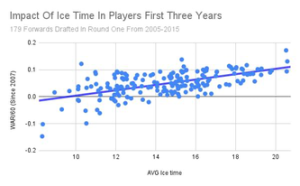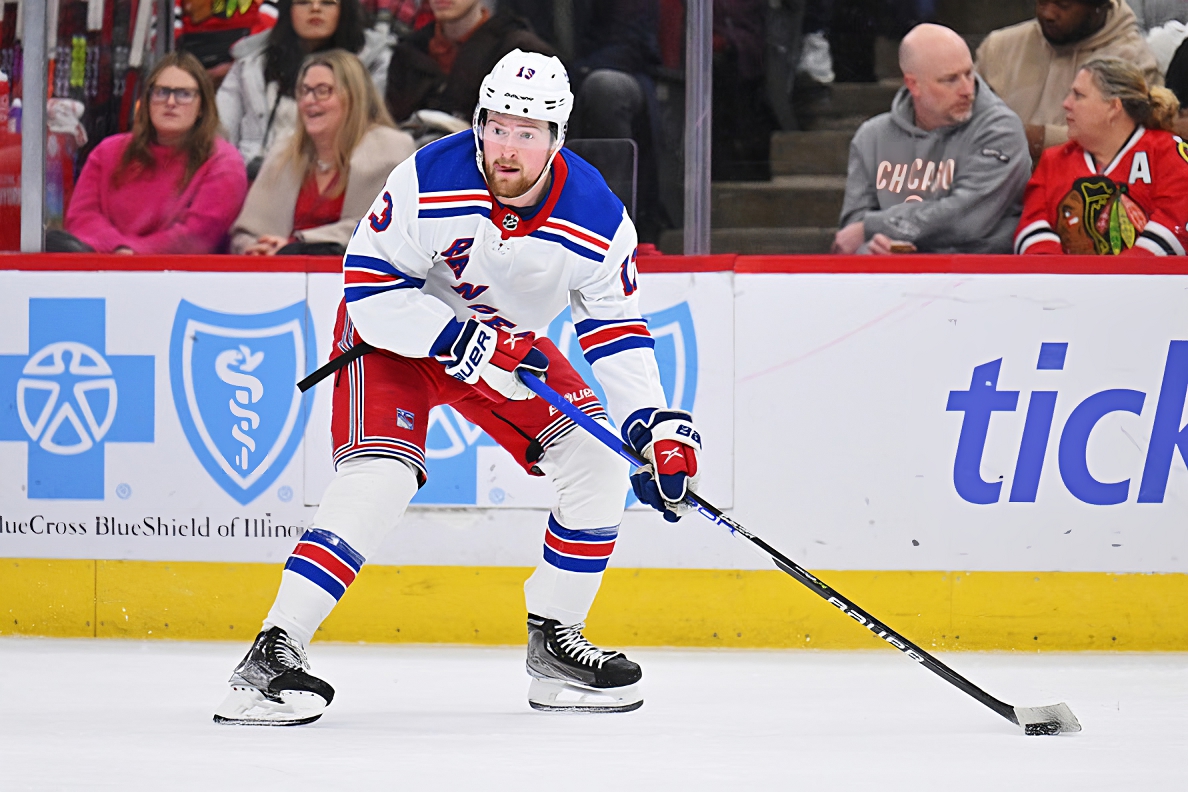Here at Last Word, we have a long series looking at the player development of first-round picks. The research into those picks looks at forwards drafted between 2005-2015 in the first round, in order to find any and all patterns as it pertains to what impacts a player’s development. Using that same research, the New York Rangers mishandling of Alexis Lafreniere can be criticized and bashed.
Rangers Alexis Lafreniere Botched Player Development
In recent years, the New York Rangers have had three notable top-10 draft picks. Those players are Alexis Lafreniere, Kaapo Kakko and Vitali Kravtsov. Let’s start with who Lafreniere was before he was drafted. Playing in the QMJHL, he posted 105 points in 61 games in his DY-1 season, and 112 points in 52 games in his draft year. That set him up for a 1.721 and 2.154 point per game paces, respectively, in those seasons.
Looking at his production, he didn’t have many QMJHL comparables. Jonathan Drouin is close, but Lafreniere out-produced him by a country mile in their respective DY-1 seasons (29 points in 33 games). Meanwhile, Sidney Crosby was much better than Lafreniere in both his DY-1 season (135 points in 59 games) and his DY (168 points in 62 games).
Looking across the other CHL leagues (OHL, WHL), he drew comparisons with Connor McDavid, Patrick Kane, and John Tavares, in terms of points per game. McDavid had rates of 1.768 and 2.553 in those respective seasons in the OHL, while Kane (1.528 in the USHL, 2.5 in OHL) and Tavares (2.0 and 1.857 in OHL) were not as directly comparable, but still close.
QMJHL Scoring Over-Evaluations
Initially, there are issues here. Not with Lafreniere necessarily, as he dominated. But the QMJHL as a league is easier to score in than the other CHL leagues. Even though Lafreniere produced similarly to those three incredible players in their respective pre-draft seasons, they did it in “tougher” leagues.
To be more specific, the average point-per-game pace for QMJHLers drafted in the first round within the specified range of players, in DY-1 seasons, was 0.905. In the OHL and WHL, it’s 0.785 and 0.697 respectively. As for DY averages, it’s the QMJHL with the highest at 1.431. Meanwhile, the OHL and WHL are down at 1.262 and 1.117, respectively.
That being said, should there have been more thought on that aspect? Not only was he playing in a generally weaker league, but there were small concerns about him as well. His skating was not elite, and his defensive zone play left a ton to be desired. One could argue Lafreniere was maybe over-evaluated offensively, which could heighten the impact his weaknesses have on his game at the next level. Doesn’t change the fact that he produced at a very high level, which only great players have achieved.
Where Alexis Lafreniere Lines Up After First NHL Season With New York Rangers
In his rookie year, Lafreniere would be disappointing. This could be for a combination of things. It could be the over-evaluation of QMJHL scoring rates, as mentioned. Or, the Rangers knew about the QMJHL scoring rates, which is easy to expect for an NHL franchise, and wanted to ease Lafreniere in. But there’s another reason. The Rangers were not a terrible team and had good wingers already in place. Artemi Panarin, Pavel Buchnevich, Chris Kreider, and previous top two pick, Kaapo Kakko were all wingers who played more on average than Lafreniere.
Overall, Lafreniere finished with 12 goals and nine assists for 21 points in the 56 games he played. That was while averaging 13:53 time on ice per game. With the ice time, he was matched up alongside Tyler Seguin and Leon Draisaitl’s respective rookie years. Both of them received tough love in the form of ice time, with 12:13 and 12:42 per game, respectively. Meanwhile, his pre-draft comparables got a big role almost instantly. McDavid, Kane, and Tavares didn’t average less than 18 per game in their rookie seasons (Tavares at exactly 18 per game).
Rangers Alexis Lafreniere After Year Two
Lafreniere went into his second season with higher hopes. With his rookie-year comps. Seguin and Draisaitl, both seeing big raises in year two, that was the expectation. Instead, that break-out never came. Despite Buchnevich getting traded, the Rangers would add Barclay Goodrow via free agency, and he would average more time than Lafreniere. That being said, asset management seemed to be the issue. The contract for Goodrow is not great (six years, at roughly $3.6mil average per year) and he provided similar offensive production as Lafreniere (33 points to 31).
On the year, Lafreniere recorded 19 goals and 12 assists for 31 points in 79 games, while averaging 13:59 per game. Basically, the same role he had played the year before, he did not receive a raise in ice time. With back-to-back years averaging about 14 minutes per game, what players did he compare to? Nail Yakupov, Alex Galchenyuk and Jonathan Drouin. Yakupov averaged 14:34 and 14:19 in his first two seasons. Galchenyuk averaged 12:19 and 14:24 per game. Finally, Drouin averaged 13:14 and 14:27. Meanwhile, his rookie-year comparables went on to get a raise. Draisaitl averaged 18:03, while Seguin went on to average 16:56.
Impacts Of Ice Time On Prospects
Ice time is pivotal to the development of prospects. Play more, produce more. Play less, produce less. Less ice time means less chance to score or grow. Simple ideology. Let’s quantify it to see just how much it impacts players. Using WAR/60 (Wins Above Replacement per 60 minutes) and the averages of all 179 forwards that were researched, and plugging it into the correlation coefficient equation, the impact is clear.
The correlation coefficient measures the dependency something has on another thing. Using the data, it will calculate how much player performance, in this case, WAR/60, to ice time. The number falls between negative one and one, and the closer it is to either end shows how strong the dependence is, positively or negatively. In this case, it had a +0.5583 coefficient, a strong relationship.

Additionally, using the same data, you can determine probabilities. Knowing the impact of ice time being strong on performance, probabilities can be solved for groups. Those groups are players who had well above average ice time across their first three seasons (16:26+ per game, two minutes or more than the average), above average ice time (14:26-16:25 per game), below average (12:26-14:25), and well-below average (less than 12:25 per game).
Lafreniere is on pace to finish his first three seasons in the below-average group. Historically, the highest probable outcome for players in that category is becoming middle-six calibre players, based on WAR/60 (36.37% probability). The next highest probability is top-six calibre (33.33% probability).
Coaching Matters Too
Ice time is not the only thing that matters in player development. Some players are simply late bloomers. Coaching matters for those players. In the case of the Rangers Alexis Lafreniere, he hasn’t had good coaches from a development standpoint. David Quinn was not included in the research, therefore he did not get a grade on how “easy” he is on younger players. However, his current coach, Gerard Gallant, was. Gallant was given a 51.0 grade based on how he handled the handful of players he coached, out of the 179 players researched. That ranked him as the 24th-best coach, out of 60.
When considering his coaches not being very kind to young players, on top of the lack of top-six minutes, and you get a very tall mountain for him to climb, with no help. It’s no wonder why he has simply not panned out. Here’s what that impact looks like in a visual.

Overall Outlook
Overall, there are a lot of things to consider when looking at why Lafreniere has not panned out well for the New York Rangers. First and foremost, his lack of a top-six role. How is he supposed to be a top-six player if he is not getting top-six minutes? Secondly, the Rangers have not hired coaches who provide a good environment for young players. That hurts even more. Then there are the smaller details of it, too.
Was his production over-evaluated? Is the QMJHL and its scoring being higher than the other CHL leagues by quite a bit paint an inaccurate picture of a player’s upside? And because of that, was he given an unfair amount of expectations by the Rangers? Then, there is the Ranger’s asset management aspect. In year one, they get a pass. In year two, they trade Buchnevich and it looks as though Lafreniere may have a top-six role opening for him. Instead, they bring in Goodrow on a long-term contract. It seemed like he was being phased out of being in a top role.
All these factors and there is no wonder why Alexis Lafreniere has truly fizzled out in New York. Maybe a trade could do wonders for him, as it did for Seguin.
Main Photo:






